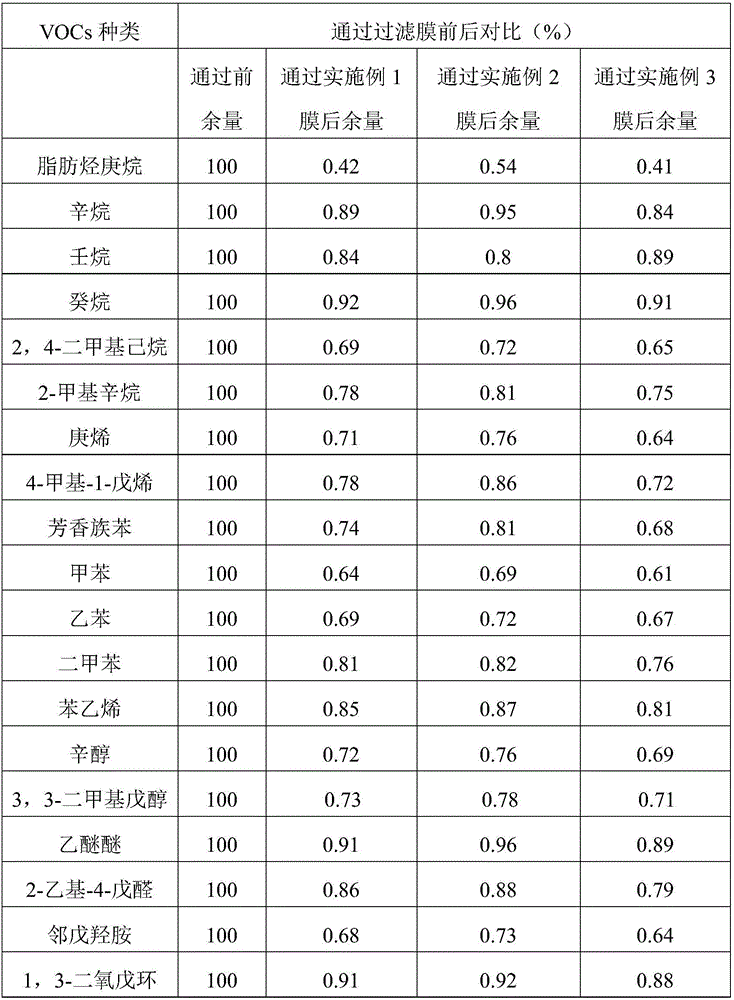Filtering membrane prepared with 3d printing technology and preparation method of filtering membrane
A 3D printing and filtration membrane technology, which is applied in membrane technology, chemical instruments and methods, and other chemical processes, can solve the problems of secondary pollution, difficult absorption and treatment of VOCs, and high processing costs, achieving low preparation costs and shock resistance Good, simple process effect
- Summary
- Abstract
- Description
- Claims
- Application Information
AI Technical Summary
Problems solved by technology
Method used
Image
Examples
preparation example Construction
[0038] The preparation method of the filter membrane prepared by the 3D printing technology comprises the following steps:
[0039] S1: Soak montmorillonite, hydrotalcite, sodium silicate, activated carbon, zeolite, and kaolin in deionized water to wash off the attached pollutants, then dry to a water content of ≤2%, and then dry the dried montmorillonite Stone, hydrotalcite, sodium silicate, activated carbon, zeolite, kaolin, and carbon fiber and glass fiber are put into a nano pulverizer, pulverized at a rotation speed of 1000-1200r / min for 1-1.5h, and passed through a sieve to obtain a mixture A;
[0040] S2: Mix the mixture A, isopropyl titanate, methyl isobutyl ketone, graphene, initiator, catalyst, and toughening agent prepared in step S1 at a temperature of 220-260°C and a speed of 400-600r / min After stirring for 2-3 hours, put it into a nano pulverizer to pulverize to obtain the mixture B;
[0041] S3: Mix the mixture B prepared in step S2, the tackifier, the coagulan...
Embodiment 1
[0045] A filter membrane prepared by 3D printing technology, including the following raw materials in parts by weight: 105 parts of montmorillonite, 65 parts of hydrotalcite, 30 parts of sodium silicate, 28 parts of activated carbon, 18 parts of zeolite, 16 parts of kaolin, 17 parts of carbon fiber, 6 parts of isopropyl titanate, 8 parts of methyl isobutyl ketone, 4 parts of glass fiber, 1.6 parts of graphene, 0.4 parts of initiator, 0.7 parts of catalyst, 0.6 parts of tackifier, 1.6 parts of toughening agent 1 part, 1 part of coagulant, 0.7 part of stabilizer.
[0046] The initiator is diisopropyl peroxydicarbonate.
[0047] The catalyst is a platinum catalyst.
[0048] The tackifier is propyltrimethoxysilane.
[0049] The toughening agent is polypropylene adiene rubber.
[0050] The coagulant is polyaluminum chloride.
[0051] The stabilizer is an organotin stabilizer.
[0052] The preparation method of the filter membrane prepared by the 3D printing technology comprise...
Embodiment 2
[0058] A filter membrane prepared by 3D printing technology, including the following raw materials in parts by weight: 80 parts of montmorillonite, 52 parts of hydrotalcite, 20 parts of sodium silicate, 23 parts of activated carbon, 15 parts of zeolite, 13 parts of kaolin, 10 parts of carbon fiber, 5 parts of isopropyl titanate, 6 parts of methyl isobutyl ketone, 3 parts of glass fiber, 1 part of graphene, 0.3 parts of initiator, 0.5 parts of catalyst, 0.4 parts of tackifier, 1.2 parts of toughening agent part, 0.8 part of coagulant, and 0.5 part of stabilizer.
[0059] The initiator is diisopropyl peroxydicarbonate.
[0060] The catalyst is a platinum catalyst.
[0061] The tackifier is propyltrimethoxysilane.
[0062] The toughening agent is polypropylene adiene rubber.
[0063] The coagulant is polyaluminum chloride.
[0064] The stabilizer is an organotin stabilizer.
[0065] The preparation method of the filter membrane prepared by the 3D printing technology comprise...
PUM
 Login to View More
Login to View More Abstract
Description
Claims
Application Information
 Login to View More
Login to View More - R&D
- Intellectual Property
- Life Sciences
- Materials
- Tech Scout
- Unparalleled Data Quality
- Higher Quality Content
- 60% Fewer Hallucinations
Browse by: Latest US Patents, China's latest patents, Technical Efficacy Thesaurus, Application Domain, Technology Topic, Popular Technical Reports.
© 2025 PatSnap. All rights reserved.Legal|Privacy policy|Modern Slavery Act Transparency Statement|Sitemap|About US| Contact US: help@patsnap.com


